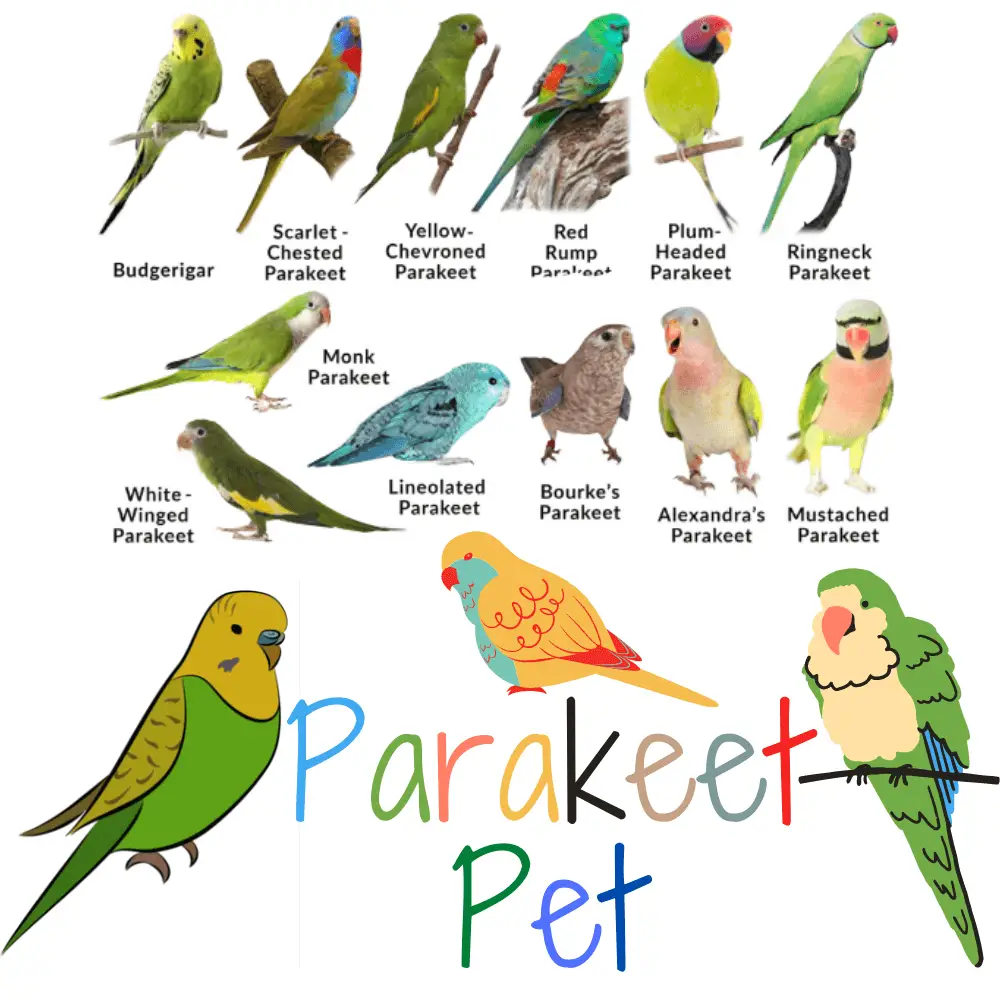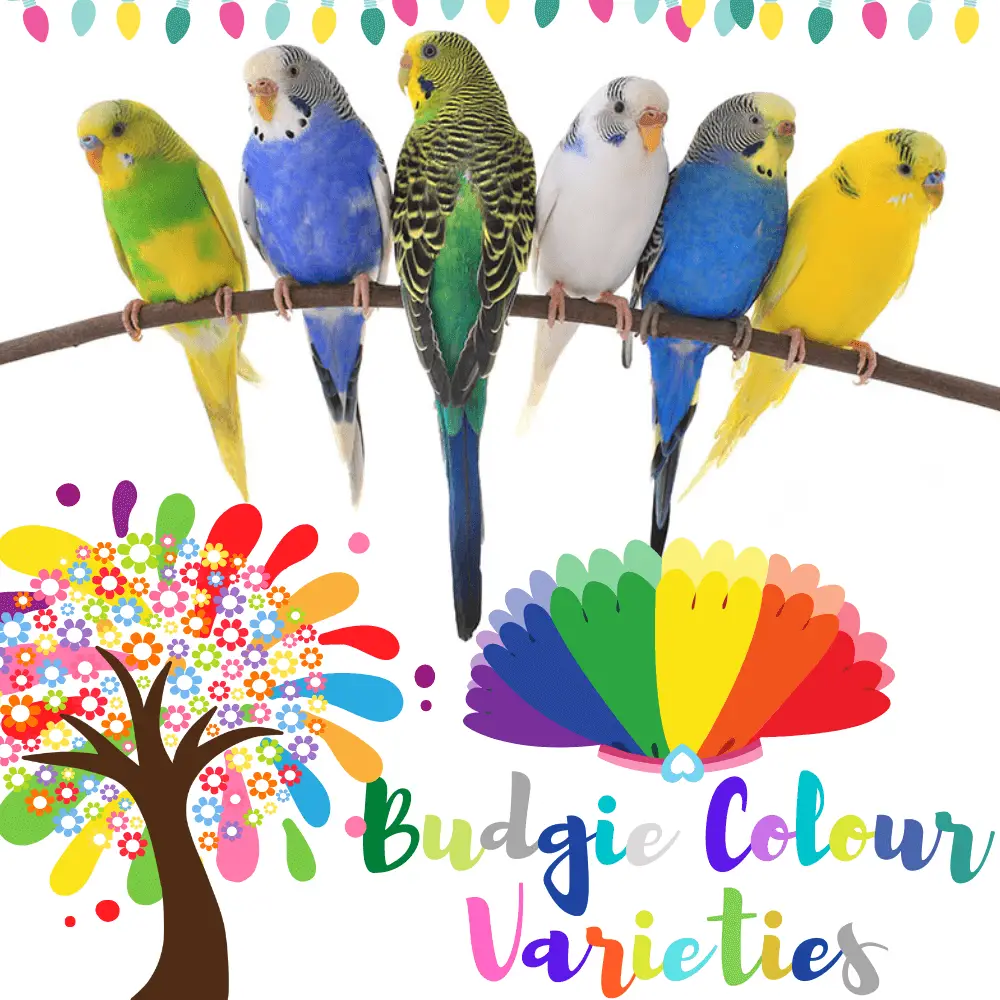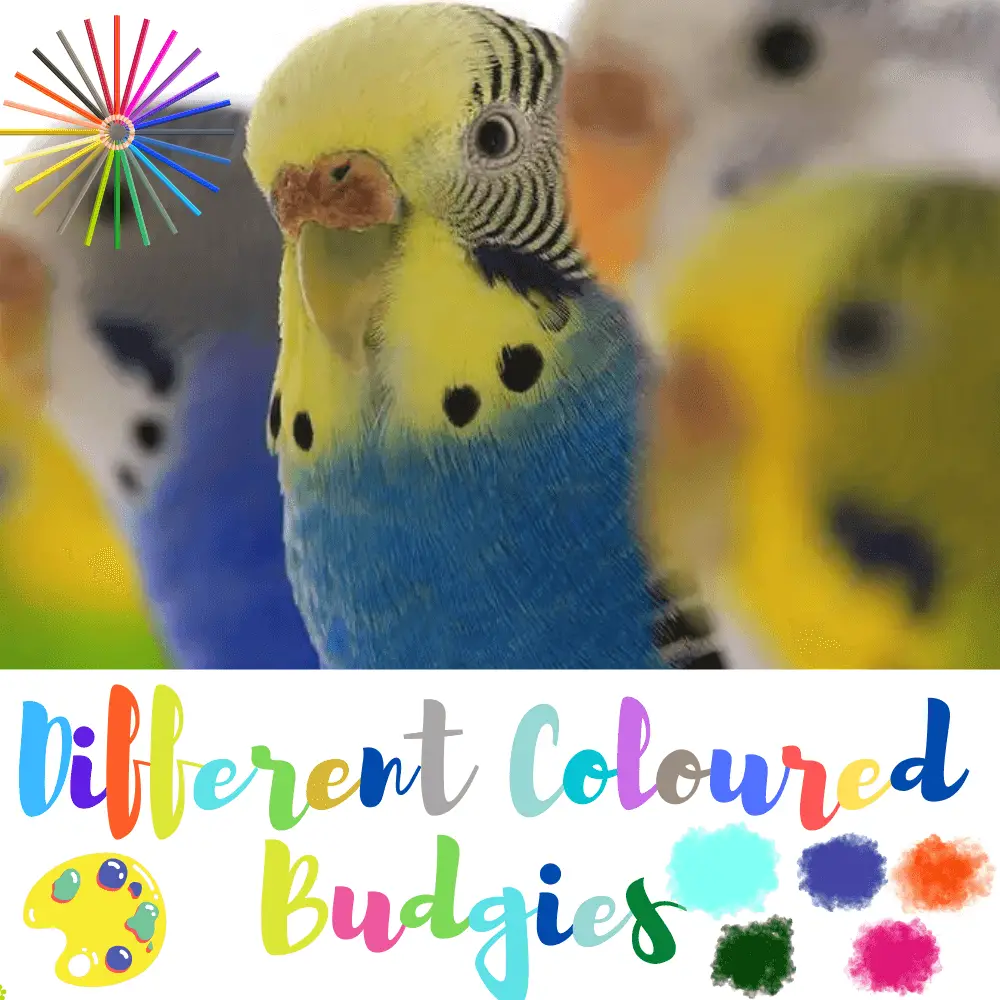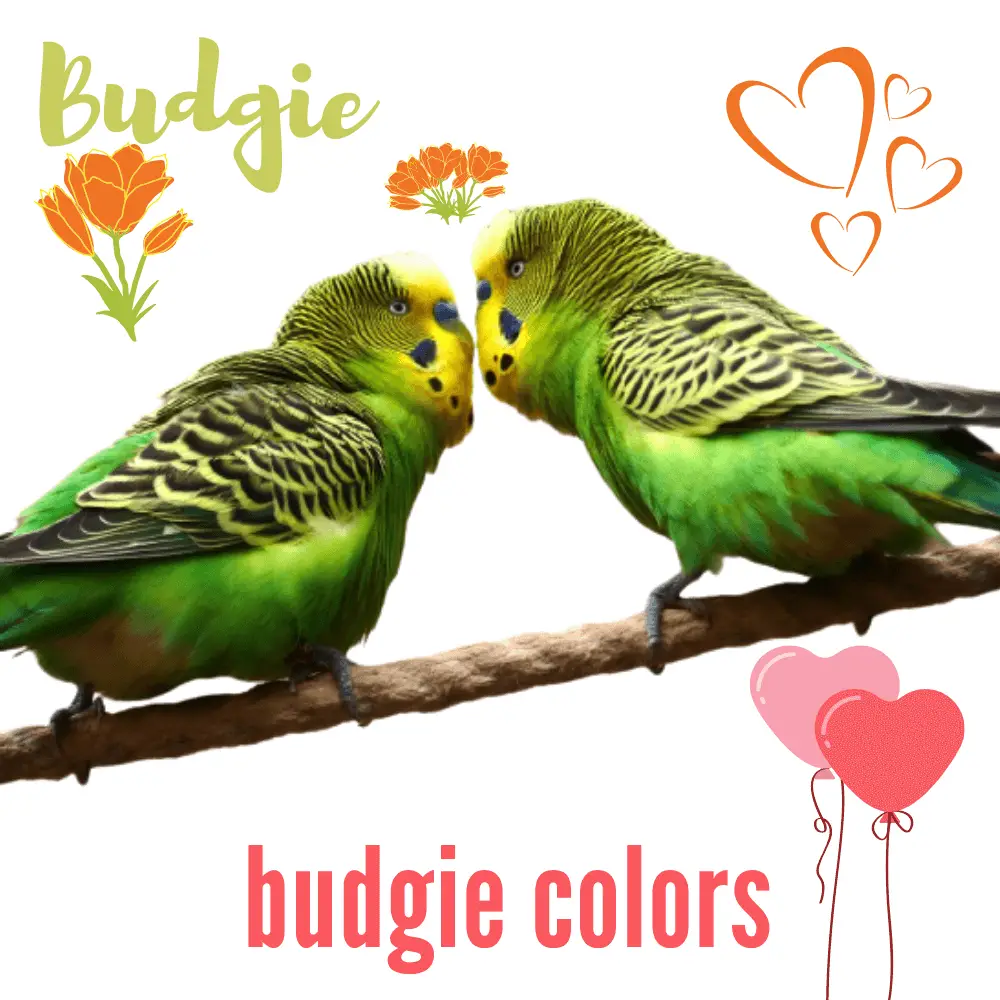
Rare Budgie Colors and Types of colors of budgies: Breeders classify their birds based on color and variety rather than “breed.” Colour describes the general plumage of budgies, while variety refers to the pattern and-or colors of their markings see the section on parakeet varieties.
Two major color groups distinguish budgies from each other: green–yellow and blue–white. The underlying hue of most budgies can be identified by the color of their mask (the area of the face between the throat and the top of the skull).
White-Based Budgie Variations
All white-based budgie variations
- Sky Blue Budgie
- Cobalt Budgie
- Mauve Budgie
- Gray Budgie
- Gray Budgie
- White Budgie
- Albino Budgie
Yellow-Based Budgie Variations
All Yellow-based budgie variations
- Light Green Budgie
- Light Green Budgie
- Olive Budgie
- Gray-Green Budgie
- Yellow Budgie
- Lutino Budgie
Colors and mutations of wavy parakeets
What a shimmer of colors offers us budgie parakeet! A real feast for the eyes. If you want to find your way around this rainbow universe, if you want to acquire some technical terms, follow the guide…
The wild wavy parakeet
Originally, the wavy parakeet lives in Australia. It was discovered there in 1770 by Captain J. Cook. It lives in arid and semi-arid regions but remains close to water sources, its life revolving around two essential activities: the search for food and water.
It lives in groups that color the sky nicely when they move in flocks that can number tens of thousands of individuals, forming especially after heavy rain. This group life is essential to protect oneself from predators and it is also what makes the parakeet a deeply social animal.
Parakeets nest together in trees, loving eucalyptus. The wild parakeet is characterized by yellow on the head, light green on the body, black for the drawing of ripples on the back, and blue on the tail.
Explanation of mutations in wavy parakeets
There are only one species of wavy parakeet, and geographical qualifiers such as “English”, “American” or “Australian” simply allowing to find one’s way between the variousMelopsittacus undulates. Wavy parakeets have never been crossed with other species and the gene pool remains limited.
“Australian” parakeets usually look a lot like wild parakeets. The “Americans” are a bit larger than the Australians, but look a lot like the Australians. The “English” are larger and their plumage is very varied in size and thickness.
A mutation is a change in color observed in the offspring of a pair of parakeets. This change is inscribed in the genes and will therefore be able to be transmitted. A mutation is hereditary and appears from birth.
The mutations are the result of a selected work of breeders, but beyond the variations in color and size, it is surprising to note that the parakeets retain their Australian rhythm, which makes it possible to reproduce them in the fall, that is to say when it is spring in Australia.
A distinction is made between parakeets carrying a color-related gene on each chromosome of the chromosomal pair (since chromosomes go in pairs) and parakeets carrying a color-related gene on only one of the two chromosomes.
There are also mutations related to the sex of the bird. The transmission will then take place from the father to the daughter. Indeed, in mammals, it is the male who has two chromosomes called X and Y, while in birds, it is the female who is XY. Genetic reasoning therefore differs. When a sex-related hereditary mutation occurs, it is always the female offspring that is impacted.
The green mutation
The green mutation is the color closest to the natural color of wavy parakeets, hence their name “wild” mutation.
The blue mutation
The blue mutation characterizes birds whose body is light blue and the front of the head, called a “mask”, is white. This mutation only concerns the color but not the ripples because the production of melanin is identical to that of the wild parakeet.
This mutation makes the yellow disappear, hence the green that turns blue on the body and the mask that changes from yellow to white. It is a recessive mutation that requires both parents to be carriers of the blue gene to obtain blue young.
If we do not know the genotype of a green mutation bird, by mating a green bird to a bluebird, you will have young carriers of the blue mutation that will be expressed to the next generation, or, if green was “blue carrier”, you will get young blue and green “blue carrier”.
The grey mutation
It is a dominant mutation. The color must be integrated as an additional factor that is added to green, in which case we will speak of gray-green or blue, and in which case we will speak of gray (short).
Dark factors
Green, blue, gray, and gray-green are basic colors.
But for each of them, there are nuances that can also be transmitted: these are the dark factors. These factors are not visible in gray and gray-green parakeets. And these factors can be either absent, present on a single chromosome, or present on both.
These dark factors manifest themselves in a green mutation parakeet:
- Light green, The so-called “wild”
- Dark green
- Olive green
- Light blue
- Cobalt
- Purple
For blue, we distinguish:
The purple mutation
The dark factors of the blue series make it possible to obtain a beautiful blue-violet called purple. A purple budgie has a dark factor and a purple factor. It is a dominant mutation but there is no purple carrier.
The opaline mutation
It is a mutation that is added to the basic color mutations (green, blue, gray, purple). It takes an expert eye to identify it. This mutation is related to sex and produces a decrease in melanin production in certain parts of the body, with ripples absent on the upper back.
Other mutations
There are still many other mutations leading to this formidable variety of appearances: diluted mutations (called “dilute”), light wings, gray wings, cinnamon, lutino, albino, lacewings, bead, yellow mask, Danish magpie, Australian magpie, Dutch magpie, ivory, black face, anthracite, black eyes, etc. This list is not even exhaustive.
The work of selection is almost a creative work and mastering the subject takes time, even without embarking on reproduction. It is, for example, easy to confuse a grey-green and an olive green. The distinction will be made at the level of the color of the ear spots (near the ears) and the shades of the tail.
But with passion, you can get to acquire a lot of knowledge. And wavy parakeets are birds that deserve our full attention, far beyond their mere appearance.
Are these Rare or Fake Budgie Mutations
SOURCE: Budgie World
The two basic color types are green and blue
Ancestral wild parakeets are a mixture of green and yellow, a very common combination in pet birds. The blue and white type is also very popular, with more or less dark variants ranging from gray to cobalt.

Different types of budgies
From the original wild parakeet, more than thirty color combinations are now observed among the tamed parakeets. Birds with these colors are not exceptions but their plumage is the result of a genetic mutation.
The mutation doesn’t just apply to captive-bred birds: it’s also seen in the wild, just as commonly, and it’s the creative core of evolution. In nature, a budgie with a mutation of a new hue will not have a reproductive advantage over its siblings of normal green hue. This means that the mutation will disappear quickly because the “strange” colored parakeet will be emulated by its suitors, who will prefer a green and yellow male, more traditional.
In captivity, however, breeders can isolate budgies with new coloration and breed them with similar birds in order to create a group of this particular type. From there, the whims and perseverance of the budgie breeder give rise to endless combinations, and with the palette of thirty different colors, the possibilities are multiple.
Different colored parakeets
This is a List of Colored Parakeets with a lifespan

| PARAKEET NAME | LIFESPAN |
|---|---|
| Budgerigar | 5-8 Years |
| Quaker parakeet | 20-30 Years |
| Alexandrine parakeet | 25 – 30 Years |
| Plum-headed parakeet | 20-30 Years |
| Derbyan Parakeet | 30 Years. |
| Nanday parakeet | 18-25 Years |
| Blue-crowned Parakeet | 25 to 30 Years |
| Crimson-bellied parakeet | 15-20 Years |
| Green-cheeked parakeet | 20-25 Years |
| Painted parakeet | 13 to 20 Years |
| Maroon-bellied Conure | 35 Years |
| Mitred parakeet | 20 to 30 Years |
| White-winged parakeet | 15 Years |
| White-eared parakeet | 19 Years |
| Red-breasted parakeet | 6 to 15 Years |
| Blood-eared parakeet | 20 Years |
| Pearly parakeet | 20 Years |
| Eastern Rosella | 20-30 Years |
| Pfrimer’s parakeet | 6-10 Years |
| Regent parrot | 15-27 Years |
| Blaze-winged parakeet | 20-25 Years |
| Black-capped parakeet | 30 Years |
| Sulfur-winged parakeet | 10-15 Years |
| Rose-crowned parakeet | 10-15 Years |
| Grey-breasted parakeet | 30 Years |
| Santarem parakeet | 15-25 Years |
| Maroon-tailed parakeet | 15-25 Years |
| Fiery-shouldered parakeet | 20 -25 Years |
| Venezuelan parakeet | 25 -30 Years |
| Rose-fronted parakeet | 10 15 Years |
Budgie colors
There are many color variations in budgie, all of which are based on the basic palette of yellow and blue pigments. Yellow and blue give green, and it is the dominant color of wild parakeets. In many domesticated varieties, the yellow pigment is absent, and the blue appears in contrast with a white (rather than yellow) base. To this must be added black.
A color totally absent in budgies is red pigmentation. Any shade of pink is related to the bird’s diet rather than a genetic tendency. This limited palette does not prevent parakeets from displaying a myriad of color variations, from smoky gray to indigo blue, pastel green, and mustard yellow. As in all animal species, there are also some albino specimens that do not have normal pigmentation.
Budgie colors

Wavy parakeets come in many colors
The dark factor (pigment), the one that changes yellow to green and blue to white, is a form of melanin called eumelanin. The yellow pigment is called psittacofulvine, often shortened by psittacine.
Color varieties of wavy parakeets
The palette is sometimes enriched by the presence of genes that influence the shade or intensity of the color, or that alter certain marks on the bird.
One of these genes is responsible for darkening the color of the plumage, and the extent of this darkening depends on the number of genes present in the parakeet (two, one, or zero). This dark genetic factor is absent in wild parakeets, whose plumage is designated as light green (wild mutation). With only 1 dark factor gene present, the parakeet becomes dark green, with 2 genes, it becomes olive green. The equivalent hues for blue mutation budgies are sky blue, cobalt, and purple blue. These last three can be complicated by genetic variations called Yellow Mask or Australian Golden Mask. Birds carrying these genes wear yellow masks on otherwise blue/white bodies (see next section on yellow-mask parakeets).
Budgie colors

Different genes determine different types of color
The palette can be declined in other colors as pleasant. The gray mutation gives an ashy hue to the parakeet’s feathers, giving green birds a khaki-gray color, and a smoky gray color on white (blue) base birds. The purple factor accentuates and darkens the colors of green/yellow and blue/white birds, sometimes resulting in electric purple plumage. The slate factor, a very rare gene, gives the parakeet a dark gray bluish color.
Parakeet color scenarios
The color of a young baby budgie depends on its parents. Dominant genes, such as those responsible for the yellow/green coloration found in wild parakeets, will have a direct influence on plumage color. Domestic parakeets, on the other hand, come in such diverse colors that it is often difficult to predict the appearance of their offspring.
For example, a bird may carry the recessive mutation for the blue/white base, “concealed” under a dominant of green/yellow feathers. The blue will not be seen on the bird, but the gene can be passed on to the next generation. If this gene is coupled with another recessive gene, the blue will eventually show itself.

In a gathering of budgies, color is very important
All dark green birds (i.e. all those that do not have the colors of wild parakeets) are the result of a genetic mutation. The most common variant, the blue/white parakeet, has simply lost its yellow pigmentation. These two basic color ranges, green/yellow and blue/white, are further complicated by the presence of various mutation genes. The colors of the markings and body are more or less dark or light, and some attributes (such as ear spots or black tips of feathers) may disappear completely.
Birds can carry one or two identical “mutant” genes, and when they have two, the effect of that particular gene (on colors or markings, for example) will only increase. In many birds, two different mutation genes combine and produce splendid results, varieties such as the Yellow Mask or the Australian Magpie mutation are examples.
The secret behind the color of a budgie lies in the genes of its parents. Breeders, therefore, know that by putting two light green parakeets together, there is a 99.99% chance that their offspring will also be light green (except for any random genetic mutations). In the same way, a light green and sky blue cross will produce a light green, because this is the dominant gene.
The next generation, however, will inherit the two genes determining colors, further mixing the genetic group. Some sky-blue genetic mutations will have been passed on, and if two of these genes combine in a single individual, the bird will then have that dominant plumage color.
Breeders therefore often choose their parent pairs very carefully, in order to produce a perfect mutation. Others like the randomness of mating different types of budgies, looking for unique variations. Most are content to simply have healthy chicks, regardless of their color or markings.
On rare occasions, a new mutation may generate a unique case, such as “Blackface” parakeets, which appeared in the 90s and disappeared in the same decade (see the next section on rare types of parakeets).
Rare Budgie Colors

Color contrasts in two young perruchons
Color change in wavy parakeets: If the plumage of a budgie changes color after the transition to adulthood, it is usually a sign of a dietary deficiency. A diet consisting solely of seeds, for example, can pose vitamin A deficiencies, and give feathers a duller appearance. Make sure your birds eat well and do not lack anything, any possible problem will be quickly solved.
It can also be caused by a lack of hygiene. If a budgie does not regularly smooth its feathers (which is its grooming), it will look discolored, dusty, and generally neglected. Give your budgie water for personal hygiene: this can be in the form of salad leaves or wet herbs, or a budgie bath (she will be happy to bathe and groom herself). Grooming includes intensive care of each individual feather, thanks to the uropygial gland (which produces a fatty body) located on the rump of the parakeet, it uses its beak to give itself a silky, waterproof, and shiny shine.
If your budgie is brutalized by others, infested with parasites, or sick, his colors will have a duller and dirtier complexion than usual. Caution is required (see our section on budgie health).
The only type of budgie that can change color over the months following molting is the opaline mentioned in the next section.
7 Rare Budgie Mutations
SOURCE:Salvador Budgie




















